INDIAN ARMED FORCES CHIEFS ON
OUR RELENTLESS AND FOCUSED PUBLISHING EFFORTS

SP Guide Publications puts forth a well compiled articulation of issues, pursuits and accomplishments of the Indian Army, over the years

I am confident that SP Guide Publications would continue to inform, inspire and influence.

My compliments to SP Guide Publications for informative and credible reportage on contemporary aerospace issues over the past six decades.
Aerospace Component Manufacturing in India: Opportunities & Challenges
The Indo-American Chamber of Commerce (IACC) organised a seminar to deliberate on the manufacturing opportunities for aviation and aerospace components under the Bilateral Aviation Safety Agreement (BASA) regime
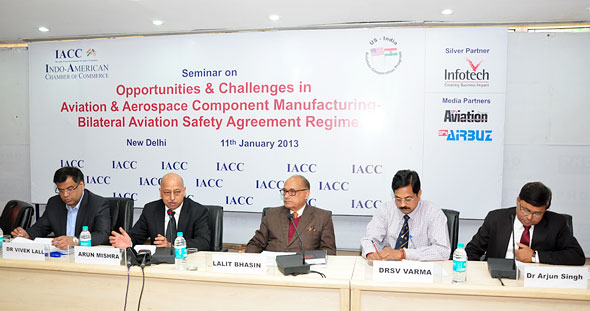
“The industry and the government have to work together to reap maximum advantage of the Bilateral Aviation Safety Agreement (BASA),” held the Director General Aviation of Civil Aviation Arun Mishra. He was delivering the key note address at a seminar organised by the Indo-American Chamber of Commerce (IACC) on “Opportunities and Challenges in Aviation and Aerospace Component Manufacturing-BASA Regime at the PHD Chamber in New Delhi on January 11.
Speaking on the occasion, Lalit Bhasin, Regional President, IACC, said that there are fond hopes of aviation scenario in India improving, but there is lack of skilled manpower and training facilities in the country. “Requirement of next generation aviation professionals is a burning issue. However, with the establishment of the proposed National Aviation University and many technical and management institutions coming up with aviation related courses, the problem would be resolved.”
Dr Vivek Lal, Chairman, IACC, NIC Aviation and Aerospace Committee and CEO, New Venture, Reliance Industries Limited, highlighted on the need for strengthening ties between different organisations and was positive about the emerging aeronautical parts manufacturing sector in India. D.R.S.V. Verma, Head, Manufacturing Initiatives, Infotech Enterprises Limited, said that the manufacturing sector in India is poised for growth but lamented that the gestation period is long.
About BASA
BASA primarily consists of two types of agreements. The first is the Executive Agreement (EA) signed between the governments of the two countries. The second is the agreement on Implementation Procedures for Airworthiness (IPA) which is signed between the civil aviation authorities of the two countries. IPA is developed to address specific areas such as (a) design approvals, (b) production approvals, (c) post design approval activities (d) technical cooperation, etc. The Government of India has signed an Executive Agreement with the Government of the United States of America (USA) on July 18, 2011 and the IPA was signed between the Directorate General of Civil Aviation (DGCA) and the Federal Aviation Authority (FAA) on November 17, 2011. DGCA is now looking ahead to the annual FAA-Asia Pacific Bilateral Partners meeting 2013 to be hosted by DGCA from April 16-18 in Bengaluru.
Session I
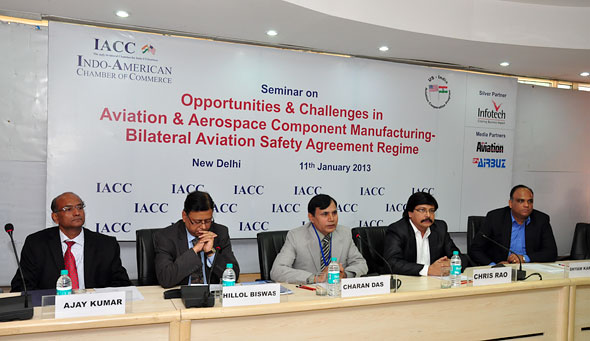
The technical session I was on “Understanding BASA” which was presided over by Charan Das, Joint Director General, DGCA. Hillol Biswas, Deputy Director, Aircraft Engineering Directorate, DGCA, spoke on the regulator aspects of BASA throwing light on shadow certification of products. He said the procedures adopted under BASA will supersede the DGCA certification. Taking it further, Ajay Kumar, Civil Aviation Specialist, FAA, US Embassy, presented the US point of view and the scope and potential of the BASA-IPA agreement. He said the purpose of it is to define the civil aeronautical products and articles eligible for import into the US and India. He gave the examples of BASA models in China, Japan, Brazil, etc. “Companies desiring to produce aeronautical products need to engage with DGCA from the design stage of the products. DGCA needs requisite technical manpower skill sets and continous training to provide world class oversight to the production of high end (new) aeronautical products and components,” he said and added that FAA stands ready to provide requisite training to DGCA officials to develop enhanced capability. Talking about the need for FAA certification, he gave the example of India’s Dhruv helicopter, which is currently going through European Aviation Safety Agency (EASA) certification to qualify for a sale to North America. “Had it gone through FAA certification, there would have been no problem.”
Chris Rao, Vice President, India Operations, UTC Aerospace Systems, spoke about Goodrich’s trip since inception, its merger with UTC and the journey ahead in aerospace manufacturing-the opportunities and growth in India. Shyam Karigiri, Senior Manager, Operations, UTC Aerospace Systems, gave out details of BASA Liferaft Shadow Certification Programme, the regular collaboration between DRDO and Goodrich, tests done, audits over a period of four and half years (2007-mid-2011).
Session II
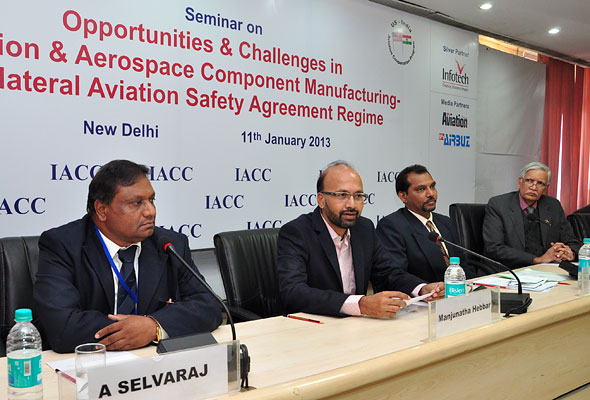
Manjunatha Hebbar was the moderator at the second session on “Component Design/Approval Process”. A. Selvaraj, Additional General Manager (Indigenisation and Technology Development), Hindustan Aeronautics Limited (HAL), spoke in detail about various programmes HAL is working on currently and concluded by stating that HAL is willing to partner with all. S.L. Deshmukh, Vice President (Technology and Industrialisation) Aerospace and Defence, Sun Group, detailed about the “BASA Processes and Provisions”. He gave a suggestion that FAA and DGCA should together list out the details of opportunities and capabilities for the global market. Prakash Eeralli, Practice Head, Engineering Process, Honeywell Aerospace, explained the difference between bilateral and International Civil Aviation Organisation (ICAO). Listing out the challenges, he said that aerospace industry has long project cycle as it involves high technology and is capital intensive. There is a need for significant investments in research and development and quality control, and manufacturers need to maintain strict quality standards.
Session III
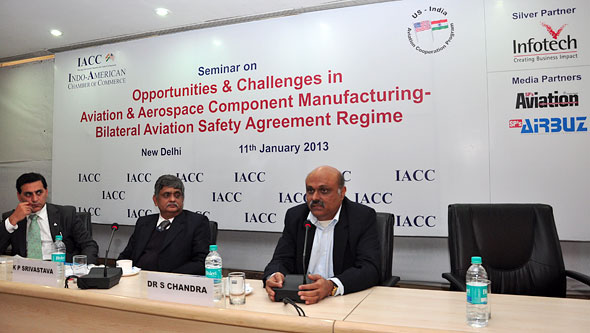
K.P. Srivastava, Director of Airworthiness, DGCA, was the moderator of the third session which was on “Standards and Certification”. Dr Satish Chandra, Head (Structure Division), National Aerospace Laboratory (NAL), described “opportunities and challenges” as “dreams and nightmares”. For a design and development person like him, what BASA means he said is establishment of design capability, establishment of compliance procedures, test capability, qualification of personnel for designing, development, manufacturing, maintenance and support, understanding of FAR clauses, advisory circulars, airworthiness, deterrence, etc. He said that there is a need to push the BASA regime to come into place as it will lead to high level of technology, process and manufacturing capability; and could revolutionise the safety culture, system design and development process in India. Dr Ajay Batra, Managing Partner, World Intellectual Property Optimisation Bank, spoke in detail about the Intellectual Property Rights, what constitutes transfer of technology (ToT) for original equipment manufacturers (OEM); the hidden clauses in technology transfer, including patents, copyright, trademarks, service marks, geographical indications, trade secrets, confidential know how, etc; intangible assets; global IPR and technology thefts; etc.
Final Session
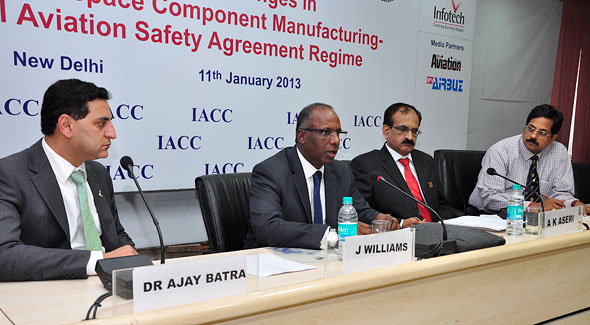
The day ended with a panel discussion on “Future Scope of BASA”. John L. Williams, President, Williams Global Advisors, who was the moderator of the session, said that lack of understanding of what the western world is looking at is a challenge for the country. He said that work of more substantive value needs to be brought to India. Panelist D.R.S.V. Varma said that BASA is a good platform, but the need of the hour is also to focus on small and medium enterprises (SMEs). A.K. Aseri, General Manager, HAL, said that never in the history of HAL, has HAL passed on the technology transferred to it by an OEM to someone else. As of date, we have 2,000 vendors and we are thinking of educating them, training them, may be build a portal. Ajay Batra said that the problem is that there are no regulatory compulsions in the country. “We are in favour of BASA but there is the need for a highly regulatory framework.”
SP’s Aviation and SP’s AirBuz were media partners of the event.





